Cobody (Upd: Jul 25, ’22)
“I say to her, Would you like to be a wolf? She answers haughtily, How stupid, you can’t be one wolf; you’re always eight or nine, six or seven. Not six or seven wolves all by yourself all at once, but one wolf among others.” – Deleuze and Guattari²
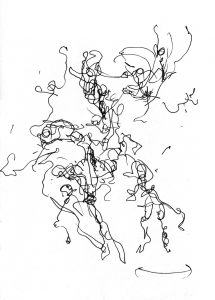
Butoh does not have to be only about the individual but can also be about the collective (cobody).³ It inherently involves the human relationship channel. All the following activities are encouraged to be executed with reduction & regeneration.
Something to also consider with group dynamic is keeping ones individual subbody but also being connected collectively. Deleuze and Guatarri express the dynamic elequently when speaking of his concept of becoming-wolf:
I am on the edge of the crowd, at the periphery; but I belong to it. I am attached to it by one of my extremities, a hand or a foot. I know that the periphery is the only place I can be, that I would die if I let myself be drawn into the center of the fray, but just as certainly if I let go of the crowd. This is not an easy position to stay in. It is even very difficult to hold, for these beings are in constant motion and their movements are unpredictable and follow no rhythm. They swirl, go north, then suddenly east; none of the individuals in the crowd remains in the same place in relation to the others. So I too am in perpetual motion; all this demands a high level of tension, but it gives me a feeling of violent, almost vertiginous happiness.²
Contemporary Metaphor Theory
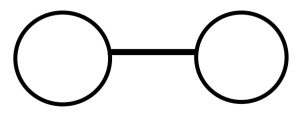
In terms of contemporary metaphor theory, cobody is powered by the LINK image schema. Image schemas to Lakoff and Johnson are “recurrent patterns in perceptual-motor experience that derive from our bodily interaction with the physical world.”6 According to SIL International Glossary of Linguistic Terms, a link schema entails “two or more entities, connected physically or metaphorically, and the bond between them.” Examples involve: (1) holding hands with somebody; (2) plugging in a lamp into the wall; (3) a casual “connection”; (4) family “ties”.7
Etymologically, “co-” means “together, with,”8 so the root meaning involves connection or link. Like so many other image schemas, we are bombarded with this link schema at all moments of our lives.
Performance Space Positions
City Park
This stage position is any number of structured, linear, or neat formations that tend to be predictable.
Rock Garden
This type of stage position looks more random or chaotic, and appears to further approach the appearance of nature. Contrasting levels (low, medium, high) are also recommended.
Cobody Roles
Rhizome Lee proposed three roles within the cobody: (1) Initiator; (2) Promoter; (3) Follower.³
Having been inspired by carcinogensis (the spread of cancer cells), he found the same crowd dynamic often happened within a group of dancers. First, there is an initiator, which can be like the initial cancer cell. This initiator takes on a certain qualia. Everybody has these initiator cancer cells, but our varying states of immunity do not allow for the process to get any further (at promoter level).
Mirroring
“Copying is about reverse‑engineering. It’s like a mechanic taking apart a car to see how it works.” – Austin Kleon4
 We can mirror another and use various types of symmetries. The initiator is the leader and the followers are those who mirror.
We can mirror another and use various types of symmetries. The initiator is the leader and the followers are those who mirror.
There are 4 main types of 2d symmetries.
1. Reflection
This is like a looking glass.
2. Translation
This is like soldiers marching in a line. This is what is used in the flocking improvisational dance exercise.
3. Rotation
This rotates around one axis.
4. Glide-reflection
This is first reflected like a mirror but and then translated. It is a combination of reflection and translation. When we walk, we naturally do this symmetry.
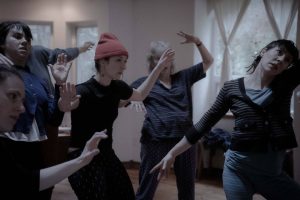
Once the 4 symmetries are identified, experiment with using them together as well. The initiator that is being mirrored can also switch roles at will, going between mirroring, not mirroring, and being mirrored.
Exercise 1: Flocking
This an exercise often done in improvisational dance. It is composed of a scattered group of dancers who mirror one leader in front of them. The leader is always in the front and the chest/torso is also facing the front. If the leader turns, then there may be a new leader. Also, a leader can jump to front to be the new leader.
Exercise 2: Shifting Mirror Loop
Two or more participants begin with looping their own personal movements and then eventually come to a middle ground where they are looping the same movement in a mirroring fashion.
Exercise 3: Two Initiatiors
Instead of one individual being mirrored, there are two (or more). We will then devise a plan on how to be at two places at once. The ones who mirror have several options:
1. The followers can form a chimera composed of the two initiators. For instance, the left arm can come from one of the intiators and the rest from the other.
2. The followers can form a stacked body composed of one base/primary mask and second mask/stacked body. For instance, one intiator is the base and the other only gives the highlights/details.
3. The idea for this exercise comes from the Butoh performer Julie Bectom Gillum. The followers go for sheer quantity and try to mirror every possibly thing from the two initiatiors. As a result, the followers may take on a much quicker tempo than the initiators in order to accomodate it all.
4. The followers can form a hybrid composed of merging the two intiators as if they both form a baby. You do the movements of the third thing/offspring.
Exercise 4: Line of Degradation
The idea behind this exercise is that there is a line of participants mirroring the individual before them, but the mirror degrades more and more the further behind the participant gets. The person at the head of the line is the creator or initiator and the mirroring gets corrupted the further down it goes, making the individual last in line the most degraded. This idea is almost like the butoh version of the Chinese whispers game where communication degrades the further down the line it is passed.
Exercise 5: Solo to Cobody Mirroring
One solo (an individual) is mirrored by one entire group as if the entire group were one body alone. So, somebody in the group (cobody) might mirror the individual’s arm while another the head, etc. The idea is to form one united body that is mirroring the body in front of them.
A variation of this exercise can entail one individual’s body part, e.g. a face mirroring an entire group representing a face, and viseversa.
The first participant is an old man who demonstrates the flight of a bird while another participant is a bird watching the old man. Both influence each other.
Exercise 7: Qualia Filter Mirroring/Flocking
One can mirror and pick any number of qualias or filters to add to the ones who are copying, e.g. they are copying but as a cloud, a bird, or a clown.
Degrees of Cooperation
“Yes, And”
“Yes, And” is an improvisational theater rule of thumb that enables the participant to accept another’s words or actions and to then add to them. The “yes” portion is the acceptance, and the “and” the addition. In essence, it’s about being a “team player.”
To engage in “Yes, And” is to engage in complete cooperation. However, perhaps we may also at times want to break the collective. Is the wolf completely a “Yes, And” or at times does he/she/they hold on by the faintest paw? If “Yes, And” means acceptance followed by addition, then what are we to take of: “Yes, But,” “No, And,” and “No, But?”
“Yes, But”
Maybe “Yes, But” relates to a participant that copies (accepts) only to then hijack the show. It’s thievery, Picasso’s “Good artists copy, great artists steal.” Steal and give no credit. Become a spy, a virus. Copy. Steal. Remix. Not even this manual is immune.
“No, And”
Maybe “No, And” is a participant that at the very start does not accept, but somehow keeps the not-accepting going and going, so that it does not grow stale. Think of Groucho Marx’s song from Horse Feathers. After all, Groucho is always keeping his non-cooperation going.
I don’t know what they have to say,
It makes no difference anyway,
Whatever it is, I’m against it.
No matter what it is or who commenced it,
I’m against it.
“No, But”
Basing off the logic of “Yes, And,” “No, But” maybe complete rejection, perhaps one falling tower that finds no other way to keep more towers falling. It is complete rejection, and the final point. Some may call it boring, but perhaps at the right timing, it may be useful, perhaps for a kyu or ending point.
Cooperation Gradient/Synthesizer Knob
Putting the cooperation degrees into a gradient, we can think of the gradient between max cooperation and max non-cooperation. We can swing back and forth or stay in one particular spot, especially a vague spot depending on one’s inner calling/resonance.
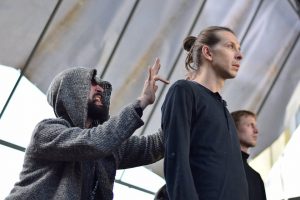
Behind World
The behind world is an important butoh cobody configuration. It references a secondary (shadow) character to the initial character (one in the spotlight or main character). Note: there can also be a behind world of the behind world (etc.), and one can eventually take it further to not literally be behind the spotlight character.
Tadashi Endo expresses this idea with the shadow that dances with you (another participant or ancestor closely behind you), which can also be seen in the film Cherry Blossoms.***
Touch
Always with consent, we can incorporate touch into the butoh practice.
Touch can form a gradient/synthesizer knob going from hidden skin/body heat (surface above the skin) to bone, which translates to the lack of pressure to much pressure on the body. This gradient can also be thought of going from hidden skin skin → skin → fascia → muscle → bone. For obvious reasons, one must be careful with resonance at the bone touch level (deep touch).
Exercise 1: Between Touching and Not Touching
When interacting with a partner, one is a constantly shifting state between touching and not touching.
Exercise 2: Moving Other via Skin (CI Instructor Otto Akkanen’s Exercise****)
With the subtle movement of the skin in some direction (think in 3d directions), the participant moves. Think of the old laptops where the mouse pointer moves by the little sensitive finger knob in the middle of the keyboard.
Exercise 3: Pressure Against Fingers (CI Instructor Otto Akkanen’s Exercise****)
This is a group exercise where people surround the center participant and place a finger on different parts of the center participant’s body. They can change the location of the finger at will. What needs to happen is that the the center participant needs to push against all the fingers at the same time.
Exercise 4: Pressure Against Fingers Network
Inspired by the exercise before, now everyone can place fingers on anyone else forming a network where everyone must keep tension. Everyone freely changes the fingers at will.
Exercise 5: Sick/Dead Contact
For those who are already familiar with the basics of contact improvisation, one can drop the emphasis of stability and enter into sick, dead, or near-dead bodies dancing together.
Exercise 6: Riding a Rolling Partner (Advanced)
This is a difficult exercise but doable. Two participants lie flat on top of each other. One participant is always on top of another without ever touching the floor with any part of the body. The base participant carefully rolls while the other stays on the body.
Poetic Ethnography by Performance Artist Guillermo Gómez-Peña
The following comes from Guillermo Gómez-Peña’s book Exercises For The Rebel Artist.9 It is a very imaginative way to integrate the body into space and art. Poetic Ethnography.
Other Exercises & Games
1. Pass the Demon
This is a mirroring exercise in a circle. One individual turns into a demon and passes this demon shape and feel around a circle. Once the demon is passed, the passer returns to a neutral state. We try to get the demon rotating around as quickly as possible. Mirroring the sound is also recommended.
2. Docking
This exercise involves a group. When one person stops, everyone stops, and when one person resumes moving, everybody resumes moving. A variation of this exercise which was shown by Imre van den Bosch, a site-specific theatre director and educator, is for the entire group to stop at the same time.***** The feat seems nearly impossible, but when the group forms a good enough connection, magic happens.
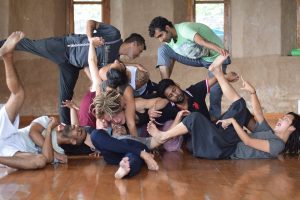
3. Sculpture
Form a butoh sculpture to freeze into. Stacking one body over another is a plus. Being upside down is also a plus. Think of a jumble, a knot, or a Hans Bellmer piece. Form into a sculpture of one absurd organism.
4. Thread Web
A good way to connect cobodies is to utilize thread. Take one thread and connect this thread to everybody, crafting a haphazard web. Nobody is to break the thread. The same exercise can then be repeated with imaginary thread. Imaginary thread can also be used. Connect one thread from one individual’s service to another’s. Move accordingly.
5. Partner Manipulation
With one blindfolded participant, another manipulates the body of another in whichever way that resonates. Choose the resistance of the blindfolded participant (0% to 100%). After, the blindfolded participant attempts to remember the manipulations and reenacts them.
6. Crazy Zipper
Grab hands in a circle. Rotate this circle and have the participants step back, forward, and around without letting go of the hands.
7. Human Knot
Similar to Crazy Zipper. The participants get in a circle and put their hands in the center then grab hands at random. They then have to undo the knot without breaking hands.
8. Space Invaders
Have the participants clump together without touching. As everybody moves in the space, all the arms spread out try and touch only the empty spaces.
9. Slow Defense & Offense
Have the participants clump together and slowly strike at each other while at the same time blocking each other.
10. Limbo
This is limbo, but butoh version. Get into any butoh character then limbo. For instance, how does a goblin limbo?
11. Paper Sheet Puppet
Have one participant manipulate a sheet of paper. Another participate mirrors the exact manipulates of the paper. If, for instance, the paper is put into a ball, the mirroring participant goes into a ball.
12. Clay Puppet
This is the same concept as Paper Sheet Puppet but with clay or Play Doh.
13. Space Equilibrium
Everyone moves throughout a space while at the same time keeping equal distance.
14. Crack the Whip
One participant is the head of the whip and travels in quick ridiculous pathways while everyone holds hands. If the whip is ever broken, participants are to immediately return to the chain.
15. Quaker Butoh
The sect of Christianity known as the Quakers engage in a practice in church where everyone sits in a circle and does not say a word unless something absolutely necessary has to be said (as if from the holy spirit itself). This idea can be enacted by butoh version. The participants can stand in a circle and everything is kept silent. Anybody can communicate in some way utilizing the body, but only if they feel it is absolutely necessary.
16. Wood Crate Tug of War
Tug of war is played from the top of a wood crate. A variation of this game is to actually have a piece of paper to tug between the two participants.
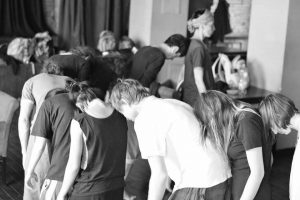
17. Caterpillar
This is a chain of participants connected from the top of the head to the front participant’s back. Modify point of connection and body part as needed.
18. Twister
Make a DIY (do it yourself) Twister game with chalk or paint, which can be bigger than the original game. Craft your own spinner. Modify as needed for intrigue and difficulty.
19. Rolling Logs
The participants align themselves into a row of rolling logs on the ground. The log at the end of the row is to quickly get up and get to the other end of the row and continue rolling. This repeats.
20. Hot Potato
Pass an object that is felt to be very hot. Keep throwing it randomly to participants. Whoever has the object when the time limit is reached, loses. Object can also be invisible.
21. Sitting Person
One individual sits in a chair and various people take turns shifting the context of why the person is in the setting.
22. Stolen Qualia
Everyone is engaged in different movements but all repetitive movements. When anybody desires, one will copy another’s movement. If this happens, then the movement has been stolen and the other person has to search for an entirely new movement.
23. Prop Transformation
24. Collection vs Assemblage
This is an exercise influenced by the philosopher Gilles Delueze.¹ The exercise involves getting into a group assemblage of any type (e.g. a group scenario that is easily recognizable by the audience such as a baseball tableau or a boxing game tableau). These scenarios have codes, and if you take one part away, the concept (in this case, the baseaballness or boxingness will disappear). Assemblages are distinguished from a mere collection because the concept of all the parts together creates something distinct and even agreed upon by witnesses.
That being said, this exercise is actually about transforming an assemblage back into a collection. A collection is like a bowl of marbles or in chemistry a mixture (you can take marbles away and it will still just be some bowl of marbles). This means, we are taking the meaning away, or creating a floating signifier/object. Woe to the audience for assuming meaning. Butoh can be quite the tickster. The sign that the audience may have felt recognizable will disintegrate or shift before their very eyes as the participants do anything except represent what the tableau seemed to suggest.
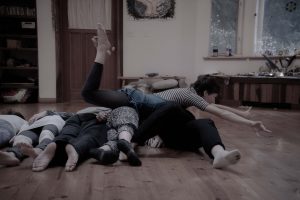
26. Ocean Waves
Participants straighten out their body with arms raised and roll together in a row on the floor (similar to log rolls) with a water qualia flow. The participant at one end will glide over the participants like a drifting body or surfer till reaching the end, and the next participant at the end will continue.
27. Resonant Repetition Control
This is an exercise for those who have worked together over a period of time. In a circle, any participant comes in for one or two minutes, and it is the duty of anybody from the surrounding circle to call out a reduction of whatever movement tendency the individual keeps coming back to. This is an exercise in noticing habits.
28. Qualia Transitioning Exercise
Separate group into two facing each other. Each group will select one qualia to embody. Group A will (like a DJ fading out and in) merge from their qualia to Group B’s qualia. The same happens with the other group.
29. Real Bug
The group carefully finds a bug that resonates with them. Dance with the bug. Or let the bug guide you. Be gentle with the bug.*
30. Front, Back, Side Following
This exercise was given in one of Özerk Sonat Pamir’s workshops which he references Anita Saij, founder of the Nordic School of Butoh.** Participants walk throughout the space and are given a series of instructions: (1) keep one person to your front at all times; (2) Keep two people in your view at all times; (3) keep one person to your front and one person to your side; (3) keep one person in your view and another outside of your view. Variations can be played with.
31. Bizarre Sign Language
This is a 2-person exercise where two people communicate to each other with a made-up non-human sign language.
32. Dancing While An Entire Group Restrains
This exercise requires at least 6 people. These 6 people will situate themselves at one body part (arms, legs, head, toros) holding them firmly to the ground. The participant will feel stuck from all sides. The participants dances despite the extreme limitations. For this type of exercise, it is recommended to have a safe word. This is a word from the participant that can signal for the exercise to stop.
De/Reterritorialized Cobody
The deterritorialized concept of cobody breaks from the general understanding of cobody (more than one person) and people are transferred into one person’s body, e.g. one leg is a sister and the other a brother. A person can also be an animal, plant, other living being, or even the transcendental/God(s).
Exercise: Deterritorialized Cobody Gradient (Advanced)
We assume a shift in perspective regarding groupings connected to our body. For instance, at the obvious level, a group of participants can be viewed as the body. This can shift either to the body parts as participants or spread to encompass the space (such as walls, floor, furniture), as part of a group or elemental spirits, bugs, or imaginary friends. The idea of “cobody” is then shifted around as if it were a synthesizer knob.